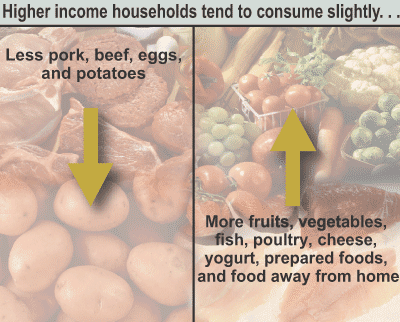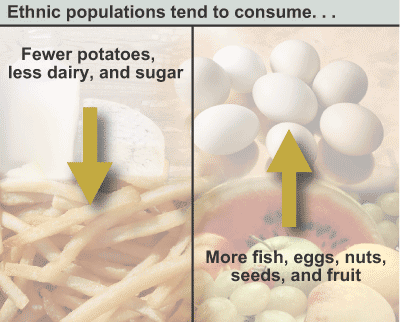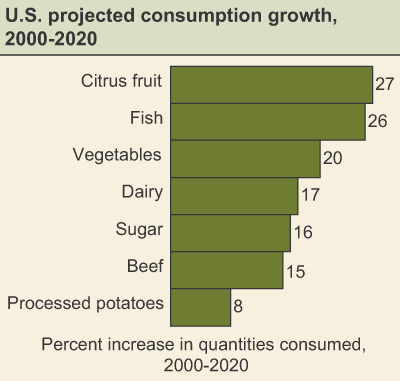Consumer-Driven Agriculture: Changing U.S. Demographics Influence Eating Habits
- by Nicole Ballenger and James R. Blaylock
- 4/1/2003
Beyond our bustling cities, America's farmlands are ostensibly a Norman Rockwell picture of calm and stability. Red barns, majestic silos, rustic farmhouses, and pastures of grazing livestock are reassuring images that recall a seemingly simpler age. Yet just beyond the old-fashioned barn door are the products of a telecommunications age that have transformed farming into a modern and global business. We find tractors equipped with global positioning systems for precision preparation and management of fields, Internet access to keep farmers abreast of current events and minute-by-minute changes in commodity prices, and sophisticated systems to manage risk, finances, and decisionmaking in a dynamic global marketplace. Today's commercial farmer can be as connected to the modern world as the urban entrepreneur.
Technology brings the varied needs and evolving wants of modern consumers living thousands of miles away to the attention of farmers. Successful producers know that consumers are key to economic viability and growth and that consumers' preferences drive the evolution of the industry. Closer business ties and stricter quality controls throughout the food supply chain are hallmarks of consumer-driven agriculture.
Recent ERS research has identified three broad demographic trends that will shape future U.S. food markets: more mature consumers, more diversity, and more people to feed. These trends were translated into projections of growth in food expenditures and in demand for specific commodities between 2000 and 2020. The ERS models do not capture some of the subtler changes in our food system; they do, however, allow us to compare the importance of the different demographic trends to specific food and commodity market segments. Moreover, we may posit whether the character of America's farmlands and farm businesses will change as much as the profile of our population 20 years from now.
More Mature Consumers
The aging of the baby boom generation, born between 1946 and 1964, will accelerate growth in the number of Americans older than 65, who will number 54 million by 2020. Although the U.S. population under age 18 will increase by 7 million by 2020, it will decline as a share of the total population. Consequently, catering to the food preferences and eating habits of older Americans—who are likely to be more health conscious than younger Americans—will be an important marketing strategy for food suppliers.
The growth of America's older population is likely to carry mixed messages for U.S. agriculture. Older Americans typically eat less food than younger ones due to lower activity levels and energy needs, and dine out less frequently. Hence, the aging trend may reduce the Nation's appetite for some foods and dampen the popularity of eating out. On the other hand, the demand for foods preferred by seniors will benefit from the age distribution shift. According to ERS projections, small declines in per capita consumption of fried potatoes, cheese, sugar, beef, and poultry are expected, while the increase in older consumers could signal an increase in per capita consumption of 'other potatoes' (such as baked), eggs, fish, fruits, and vegetables.
A Mature Market
American consumers participate in a food system that is characterized by the fulfillment, if not satiation, of basic needs—what is termed a mature market. Consumers of all ages and recent immigrants have higher standards of living now than in earlier times, and benefit from a highly productive agricultural sector. Consequently, most people are generally very well-fed and not apt to need or want larger quantities of food. However, rising incomes allow Americans to continue to upgrade their food choices to include, for example, more expensive cuts of meats, exotic vegetables, luxury food items, ready-to-eat meals, and higher priced restaurants.
Real per capita income grew 1.8 percent per year during 1978-88 and 1.2 percent per year during 1988-98. A conservative forecast of real per capita income growth is that it will continue to grow about 1 percent annually between 2000 and 2020. Of concern to suppliers of mature U.S. food markets is how much of their higher disposable incomes American consumers will spend on food and what food products will be demanded.
Over the past few decades, Americans have dedicated a declining share of their household budgets to food. Consumers with rising incomes are, however, quite willing to increase food spending if it means acquiring more convenience, better quality, or more of other valued food attributes. In a sense, higher incomes allow food choices to become expressions of personal preferences, values, and lifestyles rather than necessities. Moreover, higher incomes allow Americans to spend more on meals away from home, whether for fast food or a candlelit dinner in an elegant restaurant. With per capita income growth projected at 1 percent annually between 2000 and 2020, per capita food expenditures in 2020 are expected to be about 6 percent above those in 2000 as a result of higher incomes.
According to ERS researchers, higher incomes drive up per capita food expenditures more rapidly than per capita quantities consumed for virtually all foods. Hence, more of the extra consumer dollar will go to 'quality' than to quantity. More prosperous consumers prefer select cuts of meat, value-added products like lamb chops trimmed and dressed and ready to pop in the oven, premarinated fish, single-serving lunchbox snacks, and prewashed and bagged salad greens. Previous studies have found that as U.S. incomes rise, consumers spend more on expensive fresh foods, prepared foods, and dining out.
According to ERS projections, rising incomes will spur faster growth in per capita spending for dining out than for at-home food purchases. Food-away-from-home spending is expected to increase by almost 10 percent per capita, due to per capita income growth alone, while food-at-home spending is expected to increase by only 3 percent due to income growth. An aging population and increasing ethnic diversity may dampen the food-away-from-home trend. Americans in their thirties and early forties tended to spend the most on food away from home over the last two decades-more than both younger, less wealthy adults and those over age 50.
Higher consumer incomes are likely to engender small shifts in demand for particular foods and commodities due to different consumption patterns observed among those with different income levels. Higher income groups are likely to favor greater consumption of fruits, cheese, yogurt, fish, and vegetables (except potatoes), and slightly less consumption of pork, beef, other meats, and eggs. Interestingly, similar consumption preferences are seen among better educated consumers. According to ERS projections, the per capita consumption shifts due to higher incomes are on the order of 0.5 to 2 percent.
A More Diverse Population
Over the next two decades, the Hispanic population is expected to grow by 1.2 million annually, compared with annual increases of 500,000 among non-Hispanic Whites and 400,000 each among Blacks and Asians. Growth among the Hispanic and Asian populations is due to both natural increase and immigration, while growth among Whites, Blacks, and Native Americans results mainly from natural increase (births minus deaths). Hispanics are expected to increase from 12.6 percent of the population in 2000 to 18 percent in 2020, and Asians are expected to increase from 3.9 percent to 5 percent.
Growing ethnic diversity has contributed to shifts in food preferences as well as a notable expansion of the American food repertoire. To profit from this diversity, U.S. food suppliers must be both cognizant of the differing preferences of population subgroups and able to creatively tap into Americans' love of novel taste experiences.
Reflecting ethnic and racial dietary preferences, a more diverse population is likely to eat more fruit, nuts and seeds, eggs, and fish. Citrus fruits may see the largest per capita gain (about 2.5 percent), driven by taste preferences of today's Hispanic population. However, a greater proportion of Hispanics and Asians in the population may reduce per capita consumption of dairy products (by a little over 1 percent) unless these groups embrace dairy products as a more integral component of their diet. A preference for rice over potatoes among the recent immigrant-based population groups may dampen demand for potatoes.
ERS researchers project that the expanding ethnic population base will increase per capita beef consumption very slightly and poultry and fish consumption somewhat more. The ethnic influence on beef consumption contrasts directly with the preferences of an aging population and may moderate the downward pressure on per capita beef demand. Greater fish consumption is linked to Asian dietary preferences, and greater poultry consumption is linked to preferences of Blacks and Hispanics. Underlying these expectations is the strong assumption that ethnic populations in 2020 will have eating preferences similar to those of today's ethnic and immigrant-based populations.
More People To Feed
The United States is indeed growing, as seen in the 2000 census count of 281 million people, 54 million more than in 1980. A large share of U.S. population growth results from a high tide of immigration initiated in the 1960s and continuing at least into the near future. By 2020, the U.S. population will likely grow another 18-28 percent, implying another 50-80 million people to feed just here at home.
Conservatively assuming that in 2020 there will be 50 million more people to feed, we project that total household food spending will increase by over 26 percent between 2000 and 2020. Fueled by growth in per capita income, we project that food-away-from-home spending will increase 27.5 percent, compared with 24.3 percent for food-at-home spending.
In a mature market, population growth is the main source of increased demand for commodities that go into food production. However, population expansion will benefit some commodities more than others because of the changing population composition and related shifts in food preferences. For example, total quantities of beef and pork consumed are projected to increase by 14-15 percent, while quantities of fish and citrus fruit consumed would increase by 26-27 percent. These projections resemble the actual growth in food supplies to the U.S. market between 1980 and 2000, when beef supplies increased 11 percent, pork supplies increased 14 percent, and total fruit supplies increased about 28 percent.
A Different Consumer, a Different Agriculture?
How important are these trends—older, wealthier, ethnically diverse consumers and more of them—to American agriculture? First, because the U.S. market is a mature market, demand for farm products will grow at just about the same pace as the Nation's population. Fortunately for U.S. producers, the prospect of a growing population sets the United States apart from most other high-income countries where population growth rates are considerably lower. For those food producers who see this projected growth in U.S.-based demand as too slow, they will need to continue to secure new markets in middle-income countries (for example, Thailand and Mexico) where both populations and incomes are expanding more rapidly than in the U.S. Other Americans both on and off the farm may view the growing demand from the U.S. market as putting more pressure on environmentally sensitive agricultural areas.
Second, the demographic changes that are altering the composition of the American population imply at least moderate shifts in consumer preferences among food categories and individual products. Entrepreneurial growers will watch and attempt to tap into these shifts. For example, the growth in demand for chili peppers illustrates the growing influence of the Hispanic population as well as America's search for low-fat flavorings. We do not anticipate shifts in food preferences sufficient to transform agricultural composition of production or the profile of the American farm landscape by 2020.
Third, and most salient, the anticipation that increasing income will have a larger impact on demand for quality and variety of foods than on quantity will continue to transform agriculture into a sophisticated business venture along the lines of other American businesses. Growth in demand for value-added food products at the supermarket and in restaurants is likely to increase the share of food dollars that go to processors and retailers, and further diminish the share to providers of basic commodity inputs. However, growers are also positioning themselves to capture a larger share of the value added. Some strategies include diversifying into high-quality or specialty crops that may carry price premiums, such as tofu-grade soybeans and vine-ripened tomatoes, and developing branded products that are more readily linked by the consumer with a particular food company, production region, or even individual farm.
Food suppliers also know that catering to the modern consumer means adopting new ways of doing business, such as accepting closer business links through contractual relationships with others in the supply chain, and using information technology systems that help monitor and control quality from the farm to retail level. Such business and technology links, though far from visible as landmarks in America's farmlands, are the new hallmarks of consumer-driven agriculture.
This article is drawn from:
- Blisard, N., Variyam, J. & Cromartie, J. (2003). Food Expenditures by U.S. Households: Looking Ahead to 2020. U.S. Department of Agriculture, Economic Research Service. AER-821.
- Lin, B., Variyam, J., Allshouse, J.E. & Cromartie, J. (2003). Food and Agricultural Commodity Consumption in the United States: Looking Ahead to 2020. U.S. Department of Agriculture, Economic Research Service. AER-820.
- FoodReview: Consumer-Driven Agriculture, Vol. 25, No. 1. (2002). USDA, Economic Research Service.




